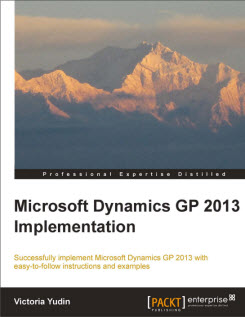Identifying reporting needs in a Microsoft Dynamics GP 2013 implementation
This article is adapted from Victoria Yudin's new book Microsoft Dynamics GP 2013 Implementation. For a chance to win a free copy of the book, visit Victoria's blog.
 Reporting is often looked at as a by-product of an ERP implementation,
something that may need to be tweaked after the implementation is completed.
Your Microsoft Dynamics GP 2013 implementation will be much more successful if
you identify the reporting needs upfront and include reporting in your
planning. There are three types of reports to consider: financial statements,
management reports, and business forms.
Reporting is often looked at as a by-product of an ERP implementation,
something that may need to be tweaked after the implementation is completed.
Your Microsoft Dynamics GP 2013 implementation will be much more successful if
you identify the reporting needs upfront and include reporting in your
planning. There are three types of reports to consider: financial statements,
management reports, and business forms.
Let us look at each of these in more detail.
Financial statements
Financial statements typically are run monthly, once the month is closed. Some companies also like to see interim financial statements throughout the month. The basic financial statements are Balance Sheet, Profit and Loss Statement (also called P&L, Income Statement, or Statement of Operations), and Cash Flow.
Most companies have many variations of financial statements, especially the Profit and Loss Statement. For example, NJW may want to have an overall company P&L as well as a separate P&L for their three revenue centers: hardware, software, and services. In addition, they would like to have an actual versus budget P&L once the budgeting functionality is in place.
As part of your planning, identify the following:
- A list of all financial statements needed. ...
FREE Membership Required to View Full Content:
Joining MSDynamicsWorld.com gives you free, unlimited access to news, analysis, white papers, case studies, product brochures, and more. You can also receive periodic email newsletters with the latest relevant articles and content updates.
Learn more about us here